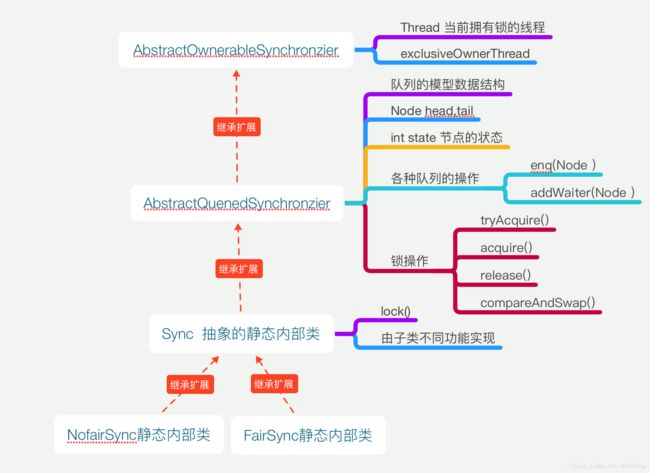ReentrantLock 源码解析
关于如何实现锁,先思考几个问题?
1、【锁资源内存访问控制】
多线程竞争的资源,如何保证在同一时刻,只被一个线程拥有,其他线程进入排队队列?
2、【等待队列模型】【公平竞争锁】【非公平竞争锁】
进入排队的线程,从【等待队列】出来,又是怎样开始获得锁的?此时获取锁,是【等待队列】的所有的线程竞争获取锁还是按照队列的顺序获取【锁】?
3、【线程之间的通信】
可重入锁怎样实现这样一个场景?: 线程获取锁,然后等待某个条件一段时间之后,发现达成条件或超时后退出。
4、【条件等待队列】
获取锁之后的线程,才能拥有条件【Condition】加入条件的等待队列,然后释放拥有的锁,等待其他线程获取锁,收到条件通知或超时退出等待队列。
5、【锁资源的等待队列模型】【锁的条件队列模型】
如何让竞争变得有序?引入【排队机制】,那怎样设计每个正在排队的【人】节点 ?
6、【引入信号量模型】
信号量,表示了当前拥有这个资源的【进程数】或【线程数】。
一、竞争资源控制
jvm 的Unsafe 的 CAS 内存操作,竞争资源是 state 字段时,通过反射获取state 的Field 对象,
compareAndSwapObject(stateField, int expected, int updated ); java 虚拟机的Unsafe操作底层能确保在同一时刻只能有一个线程更新值。
二、排队的【节点 Node 】数据结构模型设计
1、状态定义,等待、取消、条件等待
2、哪个线程?thread
3、排队的位置,前后是谁?形成了双向链式表
static final class Node {
/** Marker to indicate a node is waiting in shared mode */
static final Node SHARED = new Node();
/** Marker to indicate a node is waiting in exclusive mode */
static final Node EXCLUSIVE = null;
/** waitStatus value to indicate thread has cancelled */
static final int CANCELLED = 1; // 排队的状态
static final int SIGNAL = -1;
static final int CONDITION = -2;
static final int PROPAGATE = -3;
volatile Node prev; // 排在前面的人
volatile Node next; // 排在后面的人
volatile Thread thread; // 排队的实体是 哪个线程?
Node nextWaiter; 条件等待队列
}
三、类设计解读与分析
ReetrantLock 具体实现是通过内部类Sync 实现的。
Sync 获取锁时,有两种实现公平锁、非公平锁。
四、公平和非公平锁在 lock()方法,实现有什么不同?
NofairLock->lock()时,先是尝试获取锁,而不是去看看当前【排队的情况】
FairLock 排队获取锁。
/** * Performs lock. Try immediate barge, backing up to normal * acquire on failure. */ final void lock() { if (compareAndSetState(0, 1)) 先去修改state,若成功,则获取锁成功,保存当前线程 setExclusiveOwnerThread(Thread.currentThread()); else acquire(1); //获取失败,再去排队。。信号量设置1. 父类实现 }
public final void acquire(int arg) { if (!tryAcquire(arg) && // 尝试获取锁成功,直接OK. acquireQueued(addWaiter(Node.EXCLUSIVE), arg)) //获取失败,先加入排队队列,Thread进入while()循环等待。 selfInterrupt();// 尝试获取锁失败,且不间断的获取锁被中断了,执行interrupt。 }
/** 公平锁实现尝试获取锁 * Fair version of tryAcquire. Don't grant access unless * recursive call or no waiters or is first. */ protected final boolean tryAcquire(int acquires) { final Thread current = Thread.currentThread(); int c = getState(); //信号量 if (c == 0) { 当前没有线程获取资源 if (!hasQueuedPredecessors() && // 前面没有排队的线程 并且 修改成功 compareAndSetState(0, acquires)) { 修改信号量为 1 setExclusiveOwnerThread(current); 保存当前线程 return true; } } else if (current == getExclusiveOwnerThread()) { //是不是当前线程已经获取了该资源? int nextc = c + acquires; 是,信号量增加,可重入锁设计 if (nextc < 0) throw new Error("Maximum lock count exceeded"); setState(nextc); 2 return true; } return false; } }
/** * Performs non-fair tryLock. tryAcquire is implemented in * subclasses, but both need nonfair try for trylock method. */ final boolean nonfairTryAcquire(int acquires) { final Thread current = Thread.currentThread(); int c = getState(); if (c == 0) { if (compareAndSetState(0, acquires)) { //直接修改信号量成功,不用查看前面是否有人。 setExclusiveOwnerThread(current); return true; } } else if (current == getExclusiveOwnerThread()) { int nextc = c + acquires; if (nextc < 0) // overflow throw new Error("Maximum lock count exceeded"); setState(nextc); return true; } return false; }
/** 不间断的方式,获取到锁 或 被中断 * Acquires in exclusive uninterruptible mode for thread already in * queue. Used by condition wait methods as well as acquire. * * @param node the node * @param arg the acquire argument * @return {@code true} if interrupted while waiting */ final boolean acquireQueued(final Node node, int arg) { 当前Node,信号量1 boolean failed = true; try { boolean interrupted = false; 没有被中断 for (;;) { final Node p = node.predecessor(); if (p == head && tryAcquire(arg)) { //循环的出口条件是:当前节点的前一个是头结点(是个空节点) setHead(node); 排在第一个且获取锁成功。 p.next = null; // help GC,前一个节点出队列。 failed = false; return interrupted; //获取成功 or 被中断 } if (shouldParkAfterFailedAcquire(p, node) && //否则获取失败应该Park. parkAndCheckInterrupt()) //检查中断否 interrupted = true; } } finally { if (failed) cancelAcquire(node); } }
五、此时发现,一个线程获取资源后,除非释放锁,不然另一个线程一直在等待中。如何实现线程之间交流?
在这里引入Netty 的一个请求、响应场景。
1、在Netty 中请求和响应是异步的,怎么才能转同步实现?引入加锁+条件等待机制,确保两个线程使用的是同一个对象既是同一个锁。
Request get(int timeOut) 获取请求,需要加锁等待,得到响应的通知后或者超时,释放锁退出。
void setResponse() 响应Handler 接收到netty的返回数据时,通知等待的线程,释放锁退出。
private void doReceived(Response res) { lock.lock();加锁 state=1,此时这个线程是怎么获取到锁的? try { response = res; if (done != null) { done.signal(); 条件通知,已经Response了。 } } finally { lock.unlock(); } if (callback != null) { invokeCallback(callback); } }
public Object get(int timeout) throws RemotingException { if (timeout <= 0) { timeout = Constants.DEFAULT_TIMEOUT; } if (!isDone()) { // 没有得到Response long start = System.currentTimeMillis(); lock.lock(); //加锁,state =1,此时加锁了,Response线程是无法得到锁的,怎么被通知的? try { while (!isDone()) { 循环 done.await(timeout, TimeUnit.MILLISECONDS); 条件等待指定时间。 if (isDone() || System.currentTimeMillis() - start > timeout) { break;// 得到通知 或者超时 } } } catch (InterruptedException e) { throw new RuntimeException(e); } finally { lock.unlock();释放锁 } if (!isDone()) { throw new TimeoutException(sent > 0, channel, getTimeoutMessage(false)); } } return returnFromResponse(); }
1、get()操作加锁了,进入了条件等待,有没有释放自己的锁?
public final boolean await(long time, TimeUnit unit) throws InterruptedException { long nanosTimeout = unit.toNanos(time); if (Thread.interrupted()) throw new InterruptedException(); Node node = addConditionWaiter(); 进入条件等待队列 int savedState = fullyRelease(node);完全释放自己的锁getState()-getState()=0 final long deadline = System.nanoTime() + nanosTimeout; 截止时间 boolean timedout = false; int interruptMode = 0; while (!isOnSyncQueue(node)) { 进入循环等待:false if (nanosTimeout <= 0L) { 超时 timedout = transferAfterCancelledWait(node); break; } if (nanosTimeout >= spinForTimeoutThreshold) LockSupport.parkNanos(this, nanosTimeout); if ((interruptMode = checkInterruptWhileWaiting(node)) != 0) break; nanosTimeout = deadline - System.nanoTime();剩余时间 } if (acquireQueued(node, savedState) && interruptMode != THROW_IE) interruptMode = REINTERRUPT; 再次获取到锁 if (node.nextWaiter != null) unlinkCancelledWaiters(); if (interruptMode != 0) reportInterruptAfterWait(interruptMode); return !timedout; }
/** * Moves the longest-waiting thread, if one exists, from the * wait queue for this condition to the wait queue for the * owning lock. * * @throws IllegalMonitorStateException if {@link #isHeldExclusively} * returns {@code false} */ public final void signal() { if (!isHeldExclusively()) 当前线程 != 拥有锁的线程 throw new IllegalMonitorStateException(); Node first = firstWaiter; 条件等待队列里的第一个等待者 if (first != null) doSignal(first); 通知 }
/** * Transfers a node from a condition queue onto sync queue. * Returns true if successful. * @param node the node * @return true if successfully transferred (else the node was * cancelled before signal) */ final boolean transferForSignal(Node node) { 被通知的 条件等待线程 /* * If cannot change waitStatus, the node has been cancelled. */ if (!compareAndSetWaitStatus(node, Node.CONDITION, 0)) return false; /* * Splice onto queue and try to set waitStatus of predecessor to * indicate that thread is (probably) waiting. If cancelled or * attempt to set waitStatus fails, wake up to resync (in which * case the waitStatus can be transiently and harmlessly wrong). */ Node p = enq(node); 等待线程 再次加入【排队Sync队列】可以继续去获取锁了。 int ws = p.waitStatus; if (ws > 0 || !compareAndSetWaitStatus(p, ws, Node.SIGNAL)) LockSupport.unpark(node.thread); 将 状态由【Condition条件等待】改为[0] -> 【signal通知】 return true; }
2、有2种队列,一是【Sync 同步队列,既是获取锁资源的排队队列】;二是【锁的条件队列】。
3、通知机制实现
(1)get() 线程【得到了锁】,然后进入了【条件等待】,【完全释放】了当前的锁,【加入了条件等待队列,状态为Condition 】,直到【再次被加入Sync 队列,且状态被修改成Signal】,等到setResponse()线程释放锁 。
(2)setResponse 线程只有在获取到锁之后,将【等待队列的第一个等待线程移到】->【Sync 队列中】,并将状态修改为【Signal】,完成了通知,释放锁。

